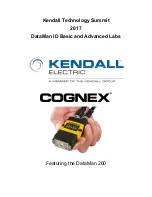
ETHERNET/IP™: Industrial Protocol
28
BC9180™ Base Station/Charger
ETHERNET/IP™ Overview
BACKGROUND
Most people who work in an office associate the term “Ethernet” with the
physical cable behind their desk. This cable connects their office PC to
the printers and servers of the local network and the infinite websites on
the Internet. This cable is only the physical part of Ethernet, the media
carrying Ethernet messages to your PC. On this wire there is a whole
series of communication protocols such as IP, the Internet Protocol; TCP,
the Transport Control Protocol; and various Microsoft protocols such as
NetBEUI. This suite of protocols works well for the office environment. It
allows users to share files, access printers, send email, search the Inter-
net and perform all the other communications used in the office environ-
ment.
The needs of the factory floor are much different, with some very special
requirements. Instead of accessing files and printers, factory floor con-
trollers must access data embedded in drive systems, operator worksta-
tions and I/O devices. Instead of making a user wait while a task is being
performed, factory floor data communications needs are real-time or
very close to real time. Terminating the fill operation on a bottle requires
much more time-precise communications than accessing the next page
of an Internet site.
Traditionally, Ethernet had only limited acceptance in Industrial Automa-
tion. Until recently the expense, lack of intelligent switches and routers
and the domination of large vendors with proprietary protocols pre-
vented the wide acceptance of Ethernet on the factory floor. Now with
prices falling, PCs with inherent Ethernet capability moving in droves
onto the factory floor and intelligent switches and routers, Ethernet is
gaining acceptance. Only the lack of a widely accepted, flexible applica-
tion layer targeted to Industrial Automation has prevented its complete
acceptance.
ETHERNET/IP™
ETHERNET/IP™ is the application layer protocol that can meet this chal-
lenge. Four independent groups have joined forces to develop and pro-
mote EIP as a public domain Ethernet application layer for Industrial
Automation. These groups include the Open DeviceNet Vendor Associa-
tion (ODVA), the Industrial Open Ethernet Association (IOANA), Control
Net International (CI) and the Industrial Ethernet Association (IEA).
The goals of this effort illustrate how EIP provides a wide-ranging, com-
prehensive, certifiable standard suitable to a wide variety of automation
devices: ETHERNET/IP™ uses all the transport and control protocols used
in traditional Ethernet including the Transport Control Protocol (TCP), the
Internet Protocol (IP) and the media access and signalling technologies
found in off-the-shelf Ethernet interface cards.
Building on these standard PC technologies means that EIP works trans-
parently with all the standard off-the-shelf Ethernet devices found in
today’s marketplace. It also means that EIP can be easily supported on
standard PCs and all their derivatives. Even more importantly, basing EIP
on a standard technology platform ensures that EIP will move forward as
the base technologies evolve in the future.
Содержание PowerScan PBT9500
Страница 1: ...BC9180 Software Reference Guide Base Station Charger Ethernet Base...
Страница 4: ...ii BC9180 Base Station Charger NOTES...
Страница 8: ...Introduction 4 BC9180 Base Station Charger NOTES...
Страница 12: ...Setup 8 BC9180 Base Station Charger NOTES...
Страница 18: ...Ethernet Host Interface Operation 14 BC9180 Base Station Charger NOTES...
Страница 50: ...ETHERNET IP Industrial Protocol 46 BC9180 Base Station Charger NOTES...
Страница 52: ...Standard Defaults 48 BC9180 Base Station Charger NOTES...
















































